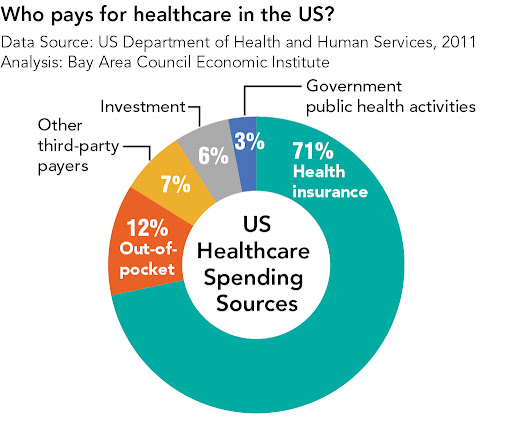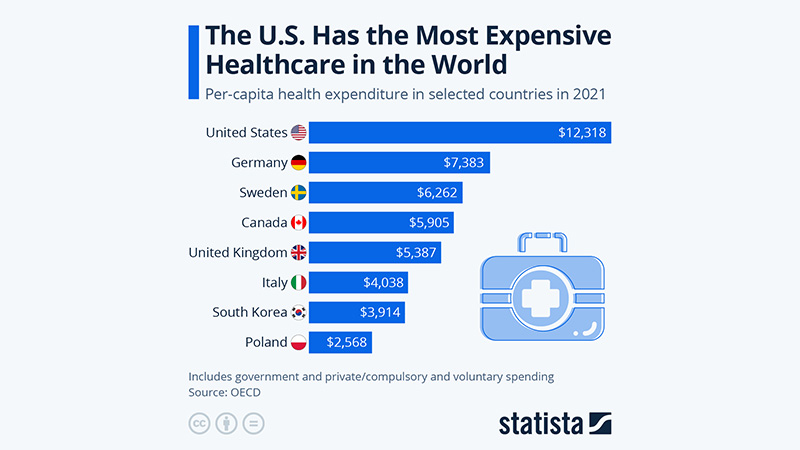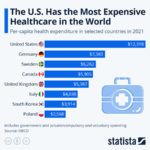Health, education, and freedom of speech are three fundamental rights of people and the basic responsibility of any government as per the Universal Declaration of Human Rights (UDHR). Among these, healthcare systems are fundamental pillars of any country’s infrastructure, playing a pivotal role in the welfare of its citizens. Government spending and policies play a crucial role in shaping the healthcare systems of nations. The two major systems that are followed across many countries are healthcare fully funded by the government through taxes and a combination of government and private healthcare systems. Countries like Canada, Switzerland, Austria, Denmark, and many more follow a universal healthcare system funded through taxes. On the other hand, countries like the United States, India, and Germany follow a model of private and public healthcare where healthcare is provided by private institutions paid through insurance systems along with healthcare either provided or funded by the government.
Both systems have their challenges, for example, in universal healthcare, wait times for patients could be longer, but every resident has an equal right to healthcare. While, the challenge with non-government-funded healthcare is that a large part of the population is not covered by insurance, as they cannot afford the cost of medical insurance. My endeavor with this blog and upcoming blogs is to create awareness and propose potential solutions to healthcare for all the people living in countries with non-government-funded healthcare systems. I would like to start by sharing my views with the world’s largest economy, the United States of America.
In the United States, healthcare is predominantly covered by private health insurance and out-of-pocket (out-of-pocket refers to when a population that does not have insurance and pays for healthcare expenses themselves) for the uninsured population. Various American governments have taken initiatives to provide healthcare to low-income and senior citizens through single-payer insurance for citizens over the age of sixty-five (Medicare), public insurance for some low-income people (Medicaid), and acts like the Affordable Care Act (ACA), the Emergency Medical Treatment and Labor Act (EMTLA). However, despite the efforts of the government 24-30 % of the US population still cannot afford healthcare.
The majority of the US population has healthcare plans purchased by employers, only 6-7% of the population buys direct private insurance. Due to the dependence on employers for providing healthcare coupled with the high deductibles, income inequality, rising prescription drug costs, and complexity of the healthcare system, a large percentage of the American population cannot afford healthcare. When employers provide insurance, if a person loses their job, they can no longer afford healthcare, which forces them to pay out-of-pocket. Along with employer dependence on insurance, income inequality, and rising prescription drug costs hinder Americans with chronic diseases from receiving care as they are not eligible to receive Medicare, and at the same time, they cannot pay for their care themselves.

who pays for healthcare in the us
Medical insurance is a necessity in the United States as even a basic doctor’s visit or an emergency service is directly or indirectly charged. For example, Emergency services are covered by the EMTLA, however, patients would be charged for the services after the basic emergency treatment. The cost for these basic services of medical care for patients could be anywhere, starting from $500 with the upper limit depending on case to case. Similarly, low-income patients, who are above the age of 65 or suffer from chronic diseases, despite being covered by Medicare and Medicaid programs, have to bear the substantial part of the cost for long-term care, prescription drugs, home and community-based services, and many more. In recent years, it has been seen that many patients of old age have been dying bankrupt or losing their homes after their death due to the large and expensive medical bills left behind for their family members. In some cases, after receiving care from Medicaid programs states are required to recover the money which they had contributed to the healthcare of the patient. As these costs are staggering, many families after the death of their parents, or grandparents need to sell their family homes just to cover the medical bills.
How can we provide healthcare service to every US resident, especially low-income groups, 25 to 40% of people who cannot afford or chronic disease patients?
Some potential ways for aiding chronic disease patients or patients who are unable to afford healthcare in the United States are government subsidization of healthcare, reduction of the cost of insurance, and reduction of the cost of medical treatment. All three possible solutions are interrelated. If the cost of medical treatment can be reduced, hopefully, the cost of insurance will decrease. With the lower cost of insurance, the government’s healthcare budgets could serve a large number of people. To provide aid to the population, governments need to increase budgets, which would allow some part of the population to afford health insurance.
How can we reduce the cost of medical treatment?
Based on my analysis of medical expenses, one of the biggest areas that caught my attention was the expense of chronic diseases. Close to 133 million people (total US population is 399 Mn) in the United States have chronic diseases and approximately constitute 87% of the total healthcare spend. Overall, the American healthcare spending on chronic diseases shows some Pareto problem characteristics (80/20) i.e. 80% being spent on resources and 20% on patients or diseases. Focusing on these high-cost conditions offers promise for significant cost reductions, however, the complexity of chronic diseases requires a nuanced approach rather than a one-size-fits-all solution.
The best solution to approach this problem is to solve it in parts rather than solving it all at once. With a large picture and roadmap, a series of well-thought-through small initiatives will help us to move closer to the goal of reducing the cost of treatment for chronic disease, resulting in reducing the healthcare cost and getting us closer to our goal of healthcare for every resident in the USA.
In my next blog, I will share my experiences and knowledge based on visits to hospitals, and senior centers, and conversations with medical experts on some ways to reduce the cost of treatment of chronic disease.
I would appreciate the feedback and input from the readers of this blog to help us give ideas to experts who are currently working in the United States and across the globe to reduce the cost of healthcare.
Sources
Forbes. ABC-CLIO eBook Collection, www.forbes.com/advisor/health-insurance/what-happens-if-you-dont-have-health-insurance/#:~:text=If%20you%20don’t%20have%20health%20insurance%2C%20you’re,even%20be%20forced%20into%20bankruptcy. Accessed 15 Apr. 2024.
The New York Times. The New York Times, www.nytimes.com/2024/03/16/health/medicaid-estate-recovery-seniors.html.
This Chart Shows Per-Capita Health Expenditure in Selected Countries in 2021. Statista, www.statista.com/chart/8658/health-spending-per-capita/. Accessed 19 Apr. 2024.
Who Pays for Healthcare in the US? www.bayareaeconomy.org/report/international-healthcare-systems-and-the-us-health-reform-debate/.















